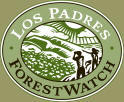|
CALIFORNIA RED_LEGGED FROG
Rana draytonii

Photo ©
californiaherps.com
The
California red-legged frog (RLF) is the largest native frog in
the western United States. The Los Padres National Forest
supports more California red-legged frogs than any other public
lands in California. These threatened frogs have been eliminated
from over 70 percent of their historic habitat, and today can be
found primarily in the coastal streams and wetlands of Monterey,
San Luis Obispo, and Santa Barbara counties.
In the
southern Los Padres, RLF were common throughout the Piru and
Sespe Creek and Ventura River drainages until about 1970, but
are all gone now except for small parts of the Ventura River
drainage. They have entirely disappeared south of Ventura
County, and their numbers are now declining along the south
coast of Santa Barbara County. The largest known populations
currently occur on the upper Carmel River, Mono Creek above Mono
Campground, and on the Santa Ynez River between Jameson and
Gibraltar reservoirs in the Santa Barbara backcountry. Look for
the tell-tale pink to red belly and hind legs if you come across
a large frog on one of your adventures on the Los Padres!
 Habitat
and Life Cycle Habitat
and Life Cycle
These frogs
have been found at elevations ranging from sea level to about
5,000 feet. They utilize a variety of habitat types, including
aquatic, riparian, and upland habitats – RLFs are sometimes
found up to 300 feet from water! They need water during the
breeding season (generally November – April) for laying their
eggs, with the males arriving at breeding sites 2-4 weeks before
the females to ‘set up camp’ and practice their singing voices.
It takes seven long and dangerous months for the fertilized eggs
to make it to metamorphosis—survival from hatching to
metamorphosis has been estimated to range as low as less than 1
percent!
Survival
often hinges on the presence of bullfrog tadpoles, which eat RLF
larvae and tadpoles (in one study, survival was estimated at
less than 5 percent for red-legged frog larvae occurring with
bullfrog tadpoles, contrasted with 30–40 percent for red-legged
frog larvae occurring without bullfrog tadpoles). The amount of
rain also affects RLF egg survival, as eggs are susceptible to
being washed away by high stream flows.

California red-legged frog
tadpole. Photo © californiaherps.com
Once they’ve
grown their legs, frog juveniles and adults may disperse from
breeding sites at any time of the year. Dispersal sites
typically include boulders or rocks and organic debris such as
downed trees or logs, which provide shelter and feeding areas.
The RLF have been recorded traveling more than two miles in
search of new dispersal sites. Frogs will remain out and about
throughout the year until water disappears, when they take
refuge in burrows.
Juvenile
frogs are busy hunting both diurnally and nocturnally, whereas
adult frogs are largely active at night. Their diet is highly
variable—tadpoles probably eat algae, insects appear to be the
most common food item for adults, and larger animals such as
Pacific tree frogs and mice represent over half of the prey mass
eaten by larger California red-legged frogs.
Threats
Several
factors combined are contributing to the extreme decline of RLF.
Predatory nonnative fish and amphibians (like introduced
bullfrogs) are particularly serious threats to red-legged frogs.
With few exceptions, the red-legged frog has disappeared from
virtually all areas where nonnative bullfrogs have become
established. Bullfrogs are larger, have more generalized food
habits, and have an extended breeding season; moreover, bullfrog
larvae are unpalatable to predatory fish—all characteristics
giving them a competitive advantage over RLF.
Other threats include impacts from
campgrounds and roads in frog habitat (including potential
crushing of frogs and egg masses from foot and vehicle traffic);
livestock grazing that degrades riparian, wetland, or upland
habitat; water diversions like groundwater extraction and stock
pond and small reservoir developments; and chytrid fungus (a
lethal skin disease).
Finally, one cannot forget the
general threat of past and continued destruction of suitable
habitat for the frogs to live and breed in. Historically the RLF
extended from Point Reyes National Seashore (just across the
Golden Gate bridge from San Francisco), as far east as the
Sierra foothills, and down into Baja California, Mexico. However
as the Central Valley became the agricultural powerhouse it is
today, more than 90 percent of historical wetlands were lost and
by 1960 the frogs were gone from most of the valley and their
old coastal stronghold of Monterey County. In Southern
California in the 1960s urbanization was having the same effect
and today the frogs are gone south of Ventura County.
Conservation & Protection
The U.S. Fish & Wildlife Service
prepared a Recovery Plan for the RLF in 2002, recommending the
development of management plans and surveys in key habitat areas
and taking other steps to reduce or eliminate threats to RLF. In
2010, the Service also designated critical habitat for RLF,
identifying key areas for the survival and recovery for RLF.
Critical habitat in the Los Padres National Forest includes the
following watersheds:
-
Monterey County: Carmel
River & Big Sur Coast
-
San Luis Obispo County:
several streams in the Santa Lucia Range, and the Upper
Salinas River
-
Santa Barbara County:
La Brea Creek, several streams along the Gaviota Coast (SB
County), and Upper Santa Ynez River
-
Ventura County:
Matilija Creek & Piru Creek
The Los Padres National Forest
continues to provide a population stronghold for California
red-legged frogs, and ForestWatch will continue to monitor
projects on the forest with the protection of the California
red-legged frog in mind.

|

